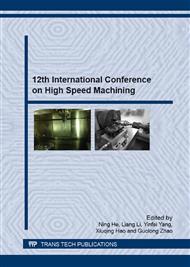p.277
p.283
p.290
p.296
p.304
p.310
p.318
p.326
p.333
Vibration Control of HSM of Thin-Wall Titanium Alloy Components Based on Finite Element Simulation
Abstract:
During high-speed machining, the vibration will result in poor workpiece surface and damage the cutting tool as well as the machine tool. It will limit the productivity and lower the quality of thin-wall titanium alloy components. Moreover, vibration occurrence is strongly affected by the dynamic response of the whole system, particularly the stiffness of workpiece-fixture system. Improper fixture layout is prone to generate vibration, especially for the flexible workpiece. Hence, it’s necessary to suppress the vibration and improve the fixture design. In this work, a finite element model of the workpiece-fixture system is built. Based on this model, the laws of the natural frequency and vibration modals under different fixturing methods are obtained, which can be used to refine fixture design. With several additional auxiliary supports, the stiffness of the workpiece-fixture system is improved and the result showed that, the natural frequencies of thin-wall titanium alloy components can be improved to a level which is too high to be reached by tool’s excitation. The result of this study is helpful to design the optimum fixture scheme of thin-wall titanium alloy components.
Info:
Periodical:
Pages:
304-309
Citation:
Online since:
January 2016
Authors:
Price:
Сopyright:
© 2016 Trans Tech Publications Ltd. All Rights Reserved
Share:
Citation:


